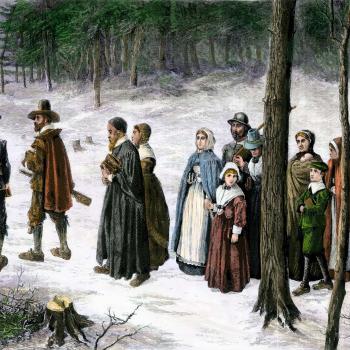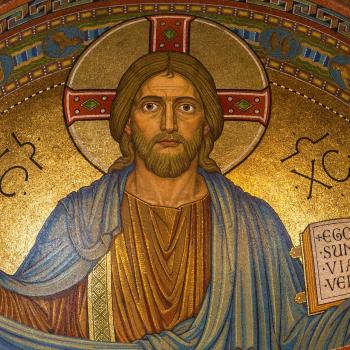We saw my family over the Easter holiday, and in preparation I wanted to make sure Sally knew the Easter story. She already knew pieces, and as I helped pull it together I was trying to figure out how to bridge fact and fiction, or at least what scholars think happen historically and what exists in the grey area beyond that.
“These stories were all written down a very long time ago,” I told her. “Sometimes with things written a long time ago it can be had to tell what part happened and what part is a story. For instance, we have old documents that talk of mermaids, half fish and half human, but scientists have never found any evidence of such creatures.”
“Says who!?!” Sally suddenly objected.
“Wait . . . what?”
“There really are mermaids, Mom,” Sally went on. “I have a Disney princess movie about one, she has red hair and a beautiful voice that can sing. Mermaids are real, Mom!”
I always forget just how awash in stories kids are at this age. Disentangling truth from falsehood can be tricky, but it’s actually more complex than that. It’s often about disentangling fact from myth, categories that don’t line up evenly with truth or falsehood. Mermaids are real, after all, in the human imagination. Myth and story have value too.
I didn’t contradict Sally’s point on mermaids because she wouldn’t have had it if I’d tried, so instead I tried to get back to the story. We talked about how, in the story, Jesus dies and rose again, a concept she was familiar with already, but I wanted to find out some way to get at the importance of all of this to her grandparents. I wanted Sally to know why Easter mattered to them.
“Your grandparents believe that Jesus came to save them,” I told her. “That’s why they call him their ‘Savior.'”
“Save them from what?” Sally asked. “Like from a giant monster or a black hole or something?”
I’ve known since Sally watched a documentary about black holes and then posited that perhaps the gods were born out of collisions between giant black holes that Sally has a thing for mixing science and myth. We as adults generally divide the world into truth and falsehood, science and fiction, but Sally is still sorting all of that out. Some months ago she concluded that the Doctor is real, but that he lives in a different universe. I find this process fascinating.
 Adults do not always make it easy for children to sort scientific fact from myth. In a world where adults confirm the existence of Santa, and where stories about fairies cross medium from movie to book to product placement, is it any wonder children can confuse the two? I’m not saying this is a problem, necessarily, or that adults need to stick to cold hard facts and never play along. Sure, we shouldn’t mock children or flat-out deceive them, but stories are interesting, and fantasy can be fun. All I’m saying is that with children’s position as novices and with the mixed messages we ourselves can send, we should be understanding when children find it challenging to sort fact from fiction.
Adults do not always make it easy for children to sort scientific fact from myth. In a world where adults confirm the existence of Santa, and where stories about fairies cross medium from movie to book to product placement, is it any wonder children can confuse the two? I’m not saying this is a problem, necessarily, or that adults need to stick to cold hard facts and never play along. Sure, we shouldn’t mock children or flat-out deceive them, but stories are interesting, and fantasy can be fun. All I’m saying is that with children’s position as novices and with the mixed messages we ourselves can send, we should be understanding when children find it challenging to sort fact from fiction.
Sean recently pointed out that Sally will likely cease believing in fairies not as a result of the scientific method but rather when her peers make fun of her for it. He’s right. This is probably part of the reason children give up belief in Santa or fairies but tend retain their belief in the deity their community worships.
But I’m probably keeping you on the edge of your seat here. How did I answer Sally’s question? I’ll be honest and say I wasn’t prepared for it and wasn’t sure how to answer it. I stumbled around trying to explain the concept of hell—which makes absolutely no sense when you try to explain it to a child of four with no concept of sin—but Sally had become distracted by something else and I don’t think she absorbed it. I’m glad, because I need my reply was lacking and I need a chance to do it over again. My parents would have said that Jesus came to “save us from our sins,” but again, Sally has no conception of sin, so that’s really not any better.
I think I’m going to read about how liberation theology and mainline denominations interpret the meaning of Jesus’ death. Then, the next time the topic comes up and Sally is curious, whenever that is, I can talk to her about the various different ideas within Christianity rather than portraying it as a monolith. I can explain the various different ways meaning is drawn from the story of Jesus’ death and resurrection, making it something she, too, is free to interpret, turn, and play around with. After all, isn’t this the whole point of stories?
In the meantime, I may want to find some more pieces of mermaid mythology at the library, so that Sally has more to go off of than Ariel alone as she explores this tradition. I’m not sure how exactly we got from Easter to Ariel, but hey, I’m not complaining. And just to psych Sally out completely, we should probably rewatch The Curse of the Black Spot.














